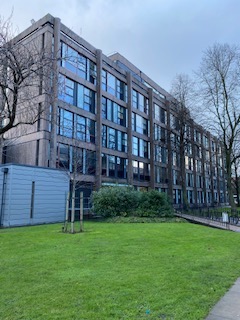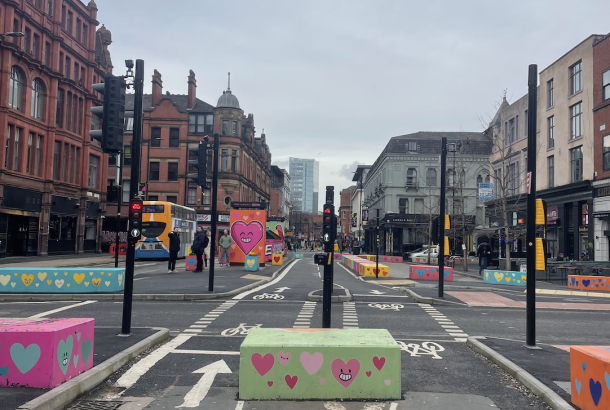The (wo)man, the myth, the building: Ellen Wilkinson

The next building of focus in our series exploring the people behind the buildings on campus is the Ellen Wilkinson building, which is used for some Humanities subjects.
The Ellen Wilkinson building, home to Education and Communication, is one of the few buildings on campus named after a woman. She gained the nickname of ‘Red Ellen’ in her political career, due to her socialist politics and vibrant red hair colour.
Wilkinson was a successful Labour party politician and feminist activist, and a passionate and bold personality in the Houses of Parliament. She was made Minister of Education under Clement Atlee’s government, making her the second woman to ever get a role in the British cabinet. She was brought up and educated in Manchester, making her legacy on the Manchester campus even more significant.
Early life
Wilkinson grew up in the working-class neighbourhood of Chorlton-upon-Medlock in Ardwick, Manchester. She was born in 1821 into a family that had very socialist values, and she was exposed to politics at a young age, perhaps explaining why she later became a passionate socialist and feminist.
In 1910, Wilkinson attended the University of Manchester to study History, which allowed her to develop her interest in socialism and politics because the labour movement and the women’s movement were both very active in Manchester. She was especially inspired by the suffragette Annot Robinson.

Political CareerWilkinson joined the National Union of Women’s Suffrage Societies in 1912 and later became a district organiser, as well as running the local branch of the Fabian Society (a British socialist organisation).
Because of her participation in these societies, Wilkinson was able to gain contact with the Labour Party, which allowed her socialist and feminist politics to mix.
She went on to become a Labour MP to try to make changes from within the system, becoming MP for Middlesbrough East in 1924 and then for Jarrow in 1935.
Wilkinson’s career as a Member of Parliament was extremely successful. It was a major achievement in itself that she was able to gain a voice in the Houses of Parliament as a woman in the 1920s, but on top of that, she was an active spokesperson for women’s interests, particularly equal franchise and equal pay. She gave women across the UK representation in government, something which was completely unheard of just 10 years earlier. Evidence of her determined nature for reform is clear through the fact that only one year into her position in the House of Commons, she introduced her first bill which sought to allow women entry into the political forces.
Her short time out of office from 1931-35 was spent voicing her opinions and representing what she believed in through journalism. She wrote for the Daily Mirror, Daily Herald and Daily Express. Some of the headlines of her articles were: ‘Women MPs are better than the men’, and ‘If I were Prime Minister’.
In 1945 she returned to politics, becoming the Minister of Education under Atlee’s government – a period of great reform in terms of moving Britain more towards a welfare state. Wilkinson’s major contributions in this role included the implementation of the Education Act in 1944, which provided universal free secondary education and raised the minimum age that you can leave school from 14 to 15. Other successes included increasing university scholarships and expanding the provision of part-time adult education through colleges. This commitment to education makes her a great person to honour on our campus.
In my eyes, Ellen is a great role model whose determined nature is something to aspire to. Having her name on a campus building is a constant reminder that determination and taking opportunities will lead to great successes in later life, and so knowing that her journey began at the University of Manchester is very inspiring.
Wilkinson joined the National Union of Women’s Suffrage Societies in 1912 and later became a district organiser, as well as running the local branch of the Fabian Society (a British socialist organisation).
Because of her participation in these societies, Wilkinson was able to gain contact with the Labour Party, which allowed her socialist and feminist politics to mix.
She went on to become a Labour MP to try to make changes from within the system, becoming MP for Middlesbrough East in 1924 and then for Jarrow in 1935.
Wilkinson’s career as a Member of Parliament was extremely successful. It was a major achievement in itself that she was able to gain a voice in the Houses of Parliament as a woman in the 1920s, but on top of that, she was an active spokesperson for women’s interests, particularly equal franchise and equal pay. She gave women across the UK representation in government, something which was completely unheard of just 10 years earlier. Evidence of her determined nature for reform is clear through the fact that only one year into her position in the House of Commons, she introduced her first bill which sought to allow women entry into the political forces.
Her short time out of office from 1931-35 was spent voicing her opinions and representing what she believed in through journalism. She wrote for the Daily Mirror, Daily Herald and Daily Express. Some of the headlines of her articles were: ‘Women MPs are better than the men’, and ‘If I were Prime Minister’.
In 1945 she returned to politics, becoming the Minister of Education under Atlee’s government – a period of great reform in terms of moving Britain more towards a welfare state. Wilkinson’s major contributions in this role included the implementation of the Education Act in 1944, which provided universal free secondary education and raised the minimum age that you can leave school from 14 to 15. Other successes included increasing university scholarships and expanding the provision of part-time adult education through colleges. This commitment to education makes her a great person to honour on our campus.
In my eyes, Ellen is a great role model whose determined nature is something to aspire to. Having her name on a campus building is a constant reminder that determination and taking opportunities will lead to great successes in later life, and so knowing that her journey began at the University of Manchester is very inspiring.







